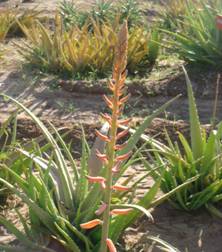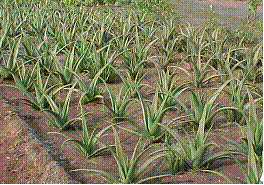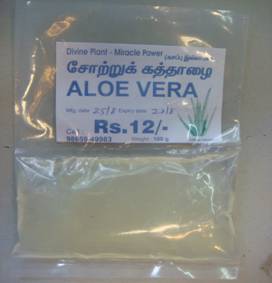Aloe (Aloe vera)
Lilliaceae
Varieties
Gurguva aloe - Aloe vera (Aloe barbadensis)
Cape aloe - Aloe ferox
Sagotrin aloe - Aloe perryi

|
Aloe vera |
These are the three mainly cultivated types of aloe. Certain other types like Zanzibar, Uganda, Natal and Hyderabad aloe are having good quality of “aloe gel”.
Soil and Climate
Well drained laterite to loamy soils is suited for aloe cultivation. The soil pH must be ranged from 7.0 to 8.5. Commercial cultivation can be done in regions having 25 – 40°C.
Seed and sowing
It is propagated through suckers. The suckers are dipped in 0.1 % Carbendazim for five minutes and planted in the field. For planting one hectare of land, 10,000 suckers are required.
Planting season
The planting can be done during two seasons namely June – July and September – October.
Planting
Field is thoroughly ploughed and beds of suitable sizes are formed. Suckers are planted at 90 x 90 cm spacing.

|
Field view |
Irrigation
It is mainly grown as rainfed crop. During summer months 4-5 irrigations are required.
Manuring
Incorporate 10 t/ha of FYM during last ploughing. For fertile soils manuring is not required at all. But for low fertile soils, apply 30 kg/ha of Nitrogen + 120 kg/ha of Gypsum during field preparation. In addition, 30 kg N can be applied after 20 days of planting.
Plant protection
No pest and disease infestation are noticed in aloe. However, under water logged condition, rotting will occur which will be overcome by good drainage practices.
Harvest
Harvesting can be done 6 – 7 months after planting. Plants are uprooted and processed (gel extraction) within 6 hours after harvest.

|
Processed aloe gel |
Yield
An average leaf yield of 15 t/ha can be obtained. |



